University International Trade Assignment: ECO3ITR/ECO2ITR Analysis
VerifiedAdded on 2023/01/17
|14
|2380
|89
Homework Assignment
AI Summary
This assignment analyzes key concepts in international trade, addressing three main questions. The first question explores absolute and comparative advantage using a hypothetical scenario, determining which country has an advantage in producing butter and cloth, and calculating gains from trade under different exchange rates. The second question applies the Ricardian model, calculating production possibility frontiers, relative prices, and comparative advantages for two countries. It then determines consumption possibilities before and after trade. The third question delves deeper into comparative advantage, autarky price ratios, and equilibrium world price ratios, and explores the impact of trade on labor returns and specialization. The assignment uses numerical examples, graphs, and economic principles to illustrate trade dynamics and welfare implications.
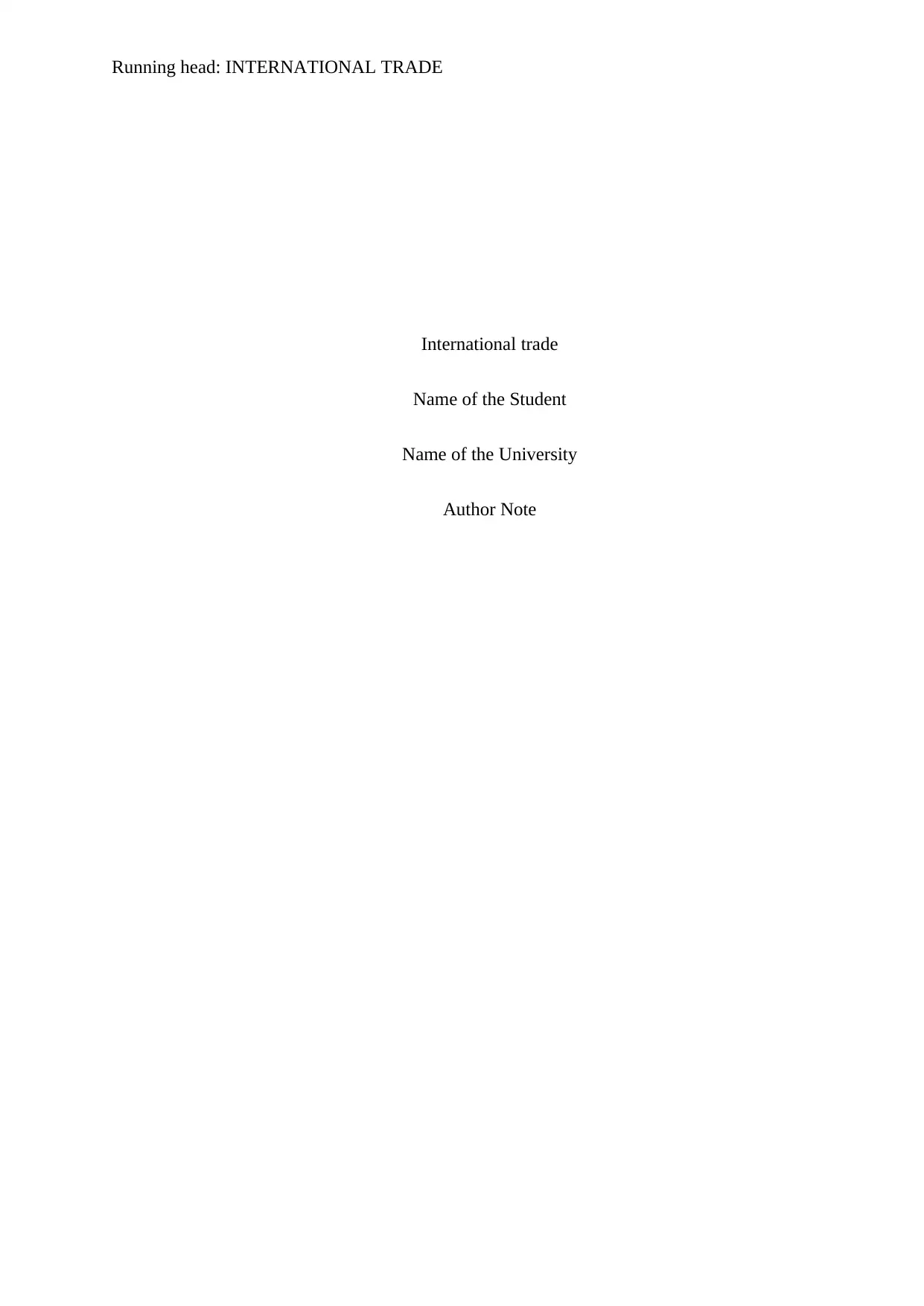
Running head: INTERNATIONAL TRADE
International trade
Name of the Student
Name of the University
Author Note
International trade
Name of the Student
Name of the University
Author Note
Paraphrase This Document
Need a fresh take? Get an instant paraphrase of this document with our AI Paraphraser

INTERNATIONAL TRADE
Table of Contents
Answer to question 1:.................................................................................................................2
Requirement a)...........................................................................................................................2
Requirement b)...........................................................................................................................2
Requirement c)...........................................................................................................................3
Answer to question 2:.................................................................................................................3
Requirement a)...........................................................................................................................3
Requirement b)...........................................................................................................................5
Requirement c)...........................................................................................................................6
Answer to question 3:.................................................................................................................8
Requirement a)...........................................................................................................................8
Requirement b)...........................................................................................................................9
Requirement c).........................................................................................................................10
Requirement d).........................................................................................................................11
Requirement e).........................................................................................................................11
Reference and Bibliography list:..............................................................................................12
Table of Contents
Answer to question 1:.................................................................................................................2
Requirement a)...........................................................................................................................2
Requirement b)...........................................................................................................................2
Requirement c)...........................................................................................................................3
Answer to question 2:.................................................................................................................3
Requirement a)...........................................................................................................................3
Requirement b)...........................................................................................................................5
Requirement c)...........................................................................................................................6
Answer to question 3:.................................................................................................................8
Requirement a)...........................................................................................................................8
Requirement b)...........................................................................................................................9
Requirement c).........................................................................................................................10
Requirement d).........................................................................................................................11
Requirement e).........................................................................................................................11
Reference and Bibliography list:..............................................................................................12
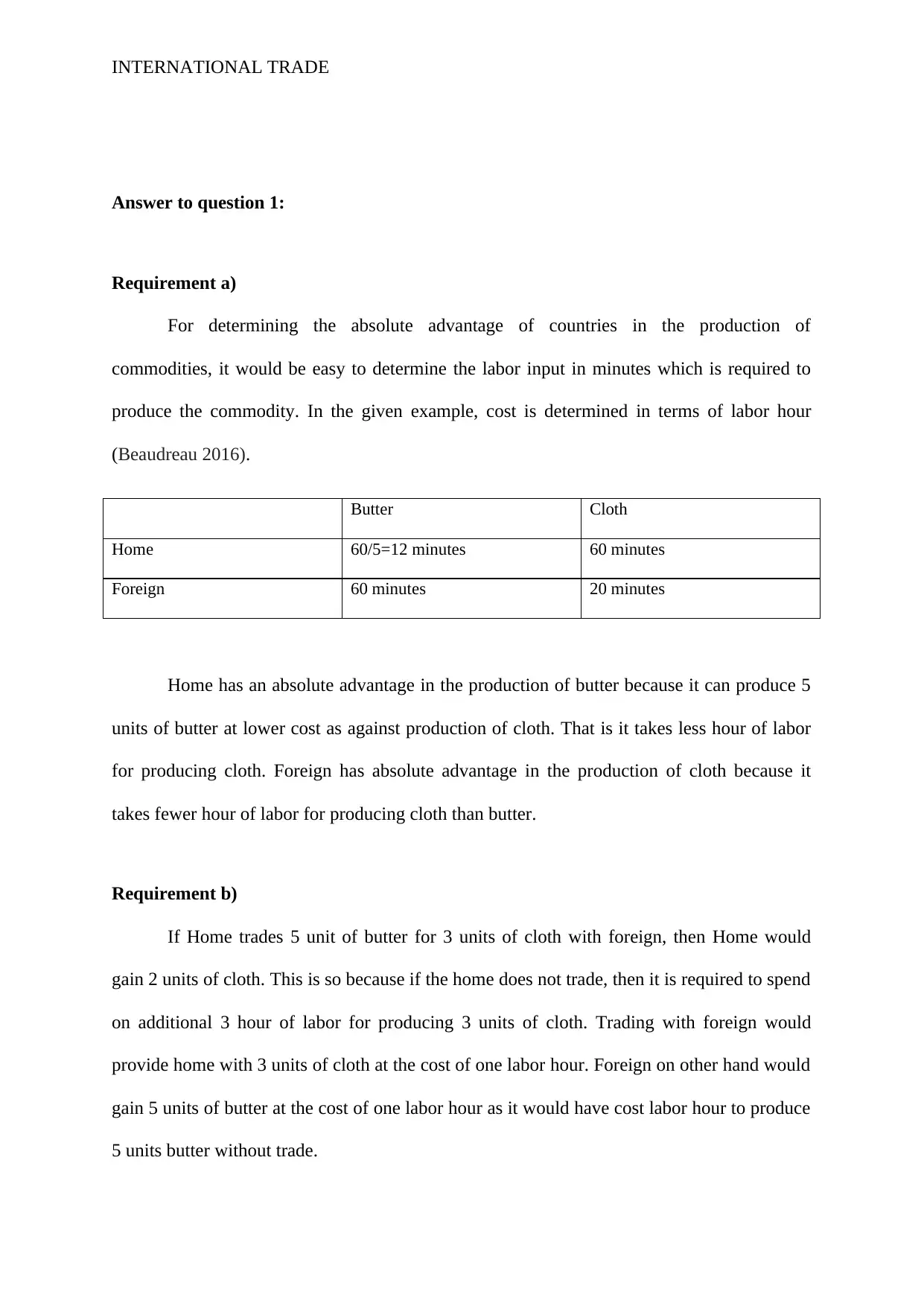
INTERNATIONAL TRADE
Answer to question 1:
Requirement a)
For determining the absolute advantage of countries in the production of
commodities, it would be easy to determine the labor input in minutes which is required to
produce the commodity. In the given example, cost is determined in terms of labor hour
(Beaudreau 2016).
Butter Cloth
Home 60/5=12 minutes 60 minutes
Foreign 60 minutes 20 minutes
Home has an absolute advantage in the production of butter because it can produce 5
units of butter at lower cost as against production of cloth. That is it takes less hour of labor
for producing cloth. Foreign has absolute advantage in the production of cloth because it
takes fewer hour of labor for producing cloth than butter.
Requirement b)
If Home trades 5 unit of butter for 3 units of cloth with foreign, then Home would
gain 2 units of cloth. This is so because if the home does not trade, then it is required to spend
on additional 3 hour of labor for producing 3 units of cloth. Trading with foreign would
provide home with 3 units of cloth at the cost of one labor hour. Foreign on other hand would
gain 5 units of butter at the cost of one labor hour as it would have cost labor hour to produce
5 units butter without trade.
Answer to question 1:
Requirement a)
For determining the absolute advantage of countries in the production of
commodities, it would be easy to determine the labor input in minutes which is required to
produce the commodity. In the given example, cost is determined in terms of labor hour
(Beaudreau 2016).
Butter Cloth
Home 60/5=12 minutes 60 minutes
Foreign 60 minutes 20 minutes
Home has an absolute advantage in the production of butter because it can produce 5
units of butter at lower cost as against production of cloth. That is it takes less hour of labor
for producing cloth. Foreign has absolute advantage in the production of cloth because it
takes fewer hour of labor for producing cloth than butter.
Requirement b)
If Home trades 5 unit of butter for 3 units of cloth with foreign, then Home would
gain 2 units of cloth. This is so because if the home does not trade, then it is required to spend
on additional 3 hour of labor for producing 3 units of cloth. Trading with foreign would
provide home with 3 units of cloth at the cost of one labor hour. Foreign on other hand would
gain 5 units of butter at the cost of one labor hour as it would have cost labor hour to produce
5 units butter without trade.
⊘ This is a preview!⊘
Do you want full access?
Subscribe today to unlock all pages.

Trusted by 1+ million students worldwide

INTERNATIONAL TRADE
Requirement c)
If the home country trades 5 unit of butter for 6 units of cloth, then would gain 5 units
of cloth as home is getting additional 5 units of cloth for cost of one labor hour. Foreign on
other hand would gain 3 units of butter at the cost of 2 labor hour. Without trade, foreign
would have to incur cost of 3 labor hour for producing 3 units of butter. Therefore, it is
saving cost of one labor hour.
Answer to question 2:
Requirement a)
Total hours of labor available in home country= 1000 hours
Total hours of labor available in foreign country= 1200 hours
The production possibility curve is the straight line intercepting the axis of motor
bikes and skate board production (Levchenko and Zhang 2016). For each country, the slope
of production possibility frontier is the opportunity cost of one skateboard in terms of the
production of motor bikes.
Motor bikes Skate boards
Home 5000 units 2000 units
Foreign 3600 units 3600 units
Requirement c)
If the home country trades 5 unit of butter for 6 units of cloth, then would gain 5 units
of cloth as home is getting additional 5 units of cloth for cost of one labor hour. Foreign on
other hand would gain 3 units of butter at the cost of 2 labor hour. Without trade, foreign
would have to incur cost of 3 labor hour for producing 3 units of butter. Therefore, it is
saving cost of one labor hour.
Answer to question 2:
Requirement a)
Total hours of labor available in home country= 1000 hours
Total hours of labor available in foreign country= 1200 hours
The production possibility curve is the straight line intercepting the axis of motor
bikes and skate board production (Levchenko and Zhang 2016). For each country, the slope
of production possibility frontier is the opportunity cost of one skateboard in terms of the
production of motor bikes.
Motor bikes Skate boards
Home 5000 units 2000 units
Foreign 3600 units 3600 units
Paraphrase This Document
Need a fresh take? Get an instant paraphrase of this document with our AI Paraphraser
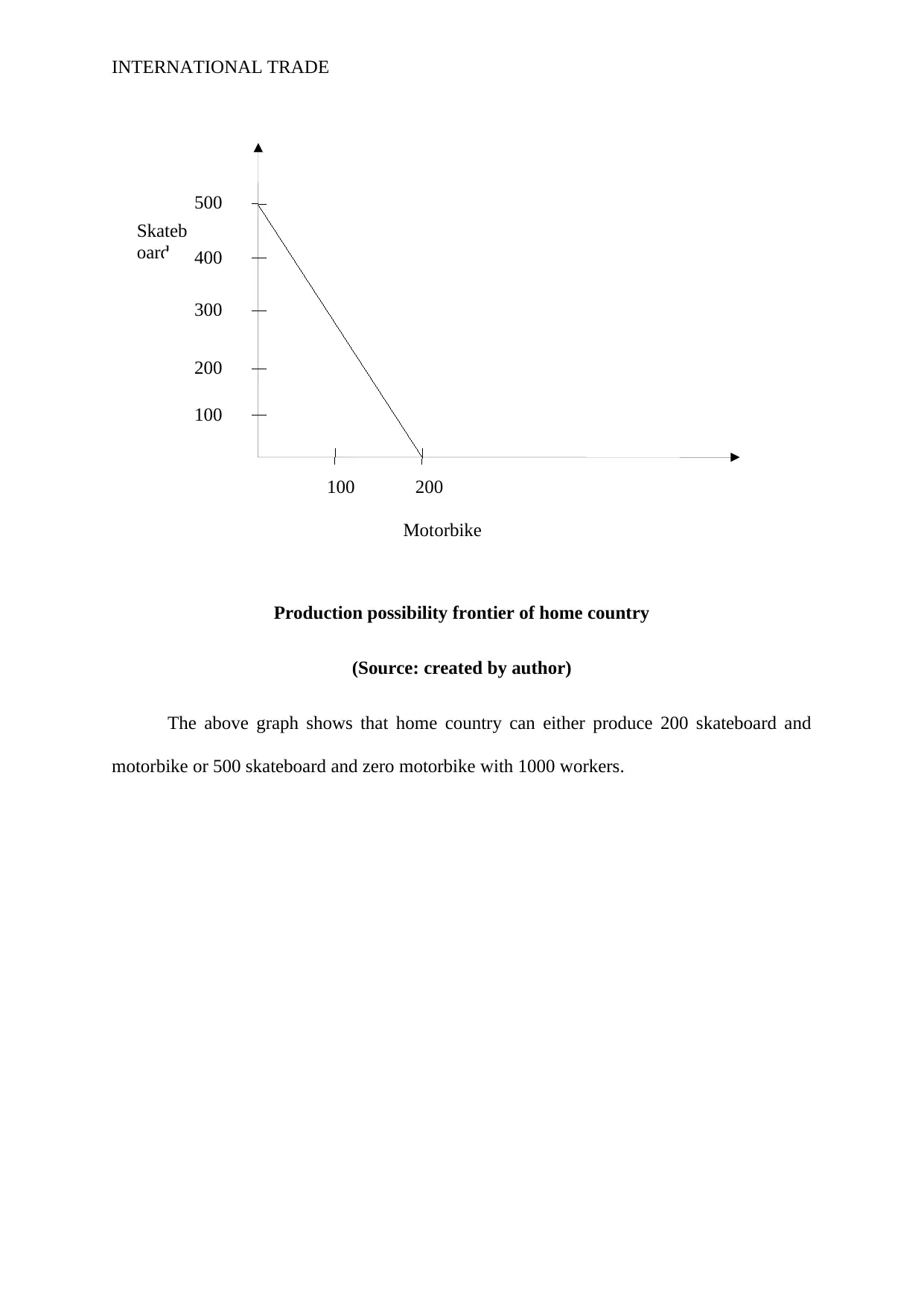
Motorbike
Skateb
oard
100 200
100
200
300
400
500
INTERNATIONAL TRADE
Production possibility frontier of home country
(Source: created by author)
The above graph shows that home country can either produce 200 skateboard and
motorbike or 500 skateboard and zero motorbike with 1000 workers.
Skateb
oard
100 200
100
200
300
400
500
INTERNATIONAL TRADE
Production possibility frontier of home country
(Source: created by author)
The above graph shows that home country can either produce 200 skateboard and
motorbike or 500 skateboard and zero motorbike with 1000 workers.
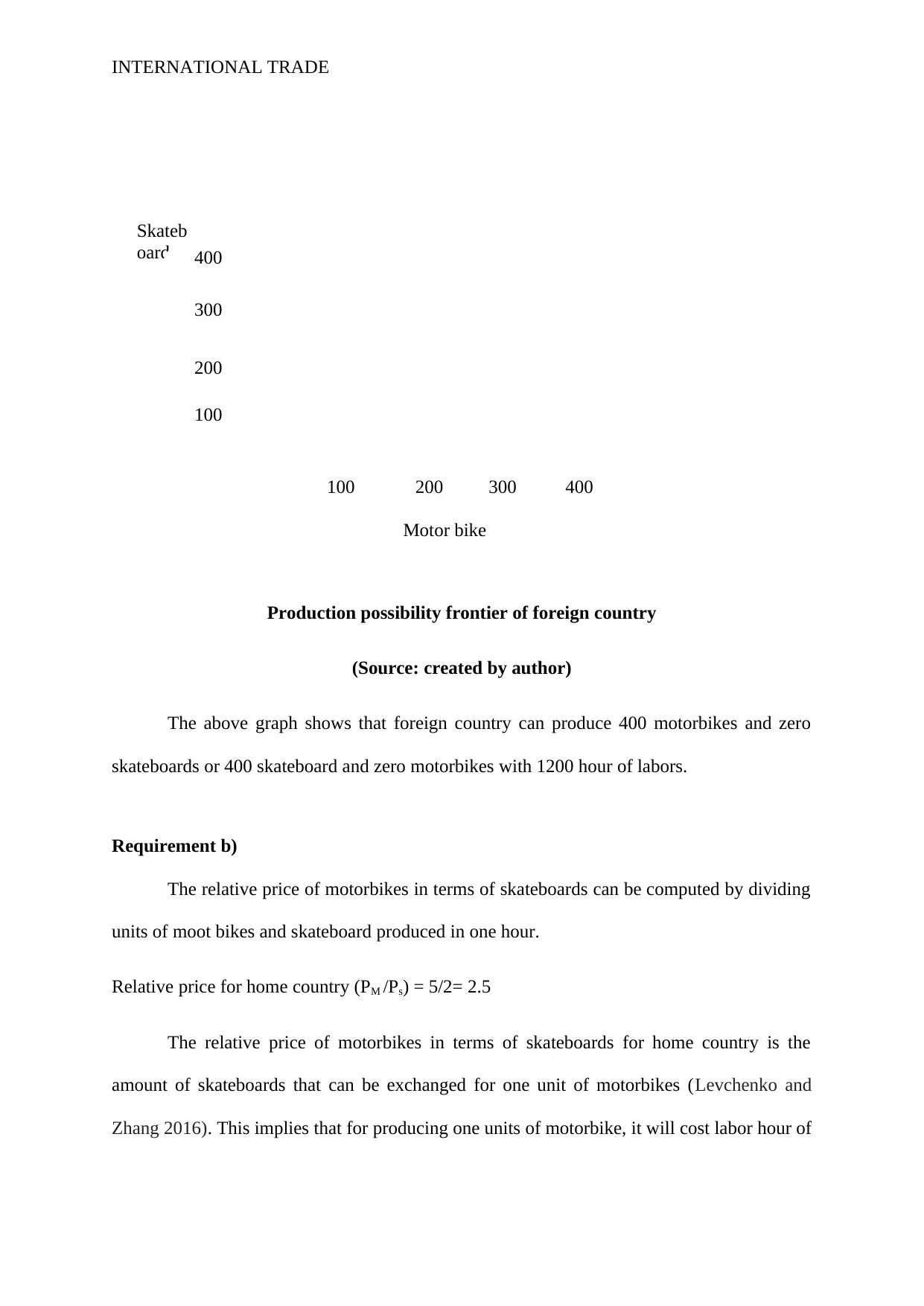
Motor bike
Skateb
oard
100 200
100
200
300
400
300 400
INTERNATIONAL TRADE
Production possibility frontier of foreign country
(Source: created by author)
The above graph shows that foreign country can produce 400 motorbikes and zero
skateboards or 400 skateboard and zero motorbikes with 1200 hour of labors.
Requirement b)
The relative price of motorbikes in terms of skateboards can be computed by dividing
units of moot bikes and skateboard produced in one hour.
Relative price for home country (PM /Ps) = 5/2= 2.5
The relative price of motorbikes in terms of skateboards for home country is the
amount of skateboards that can be exchanged for one unit of motorbikes (Levchenko and
Zhang 2016). This implies that for producing one units of motorbike, it will cost labor hour of
Skateb
oard
100 200
100
200
300
400
300 400
INTERNATIONAL TRADE
Production possibility frontier of foreign country
(Source: created by author)
The above graph shows that foreign country can produce 400 motorbikes and zero
skateboards or 400 skateboard and zero motorbikes with 1200 hour of labors.
Requirement b)
The relative price of motorbikes in terms of skateboards can be computed by dividing
units of moot bikes and skateboard produced in one hour.
Relative price for home country (PM /Ps) = 5/2= 2.5
The relative price of motorbikes in terms of skateboards for home country is the
amount of skateboards that can be exchanged for one unit of motorbikes (Levchenko and
Zhang 2016). This implies that for producing one units of motorbike, it will cost labor hour of
⊘ This is a preview!⊘
Do you want full access?
Subscribe today to unlock all pages.

Trusted by 1+ million students worldwide
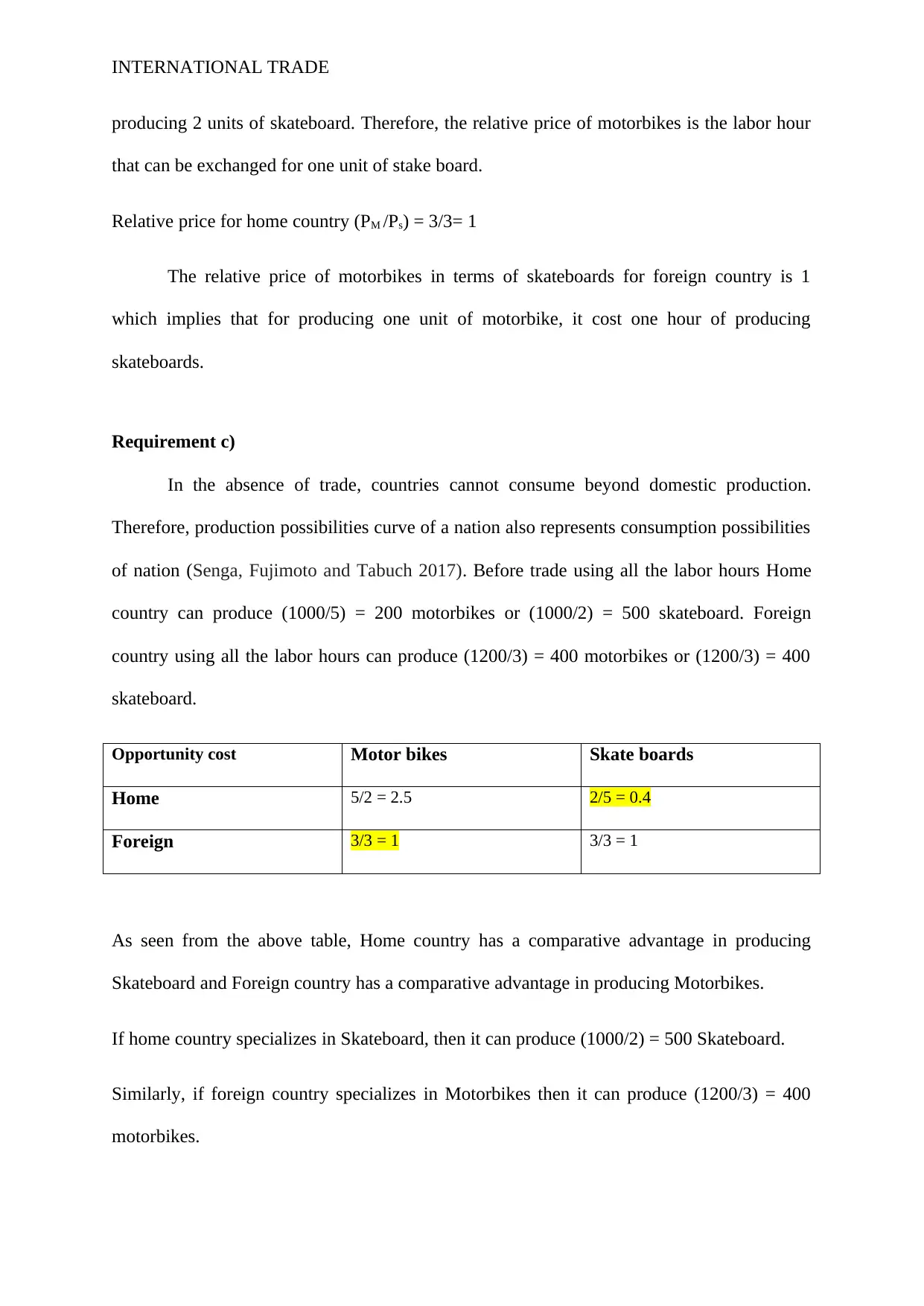
INTERNATIONAL TRADE
producing 2 units of skateboard. Therefore, the relative price of motorbikes is the labor hour
that can be exchanged for one unit of stake board.
Relative price for home country (PM /Ps) = 3/3= 1
The relative price of motorbikes in terms of skateboards for foreign country is 1
which implies that for producing one unit of motorbike, it cost one hour of producing
skateboards.
Requirement c)
In the absence of trade, countries cannot consume beyond domestic production.
Therefore, production possibilities curve of a nation also represents consumption possibilities
of nation (Senga, Fujimoto and Tabuch 2017). Before trade using all the labor hours Home
country can produce (1000/5) = 200 motorbikes or (1000/2) = 500 skateboard. Foreign
country using all the labor hours can produce (1200/3) = 400 motorbikes or (1200/3) = 400
skateboard.
Opportunity cost Motor bikes Skate boards
Home 5/2 = 2.5 2/5 = 0.4
Foreign 3/3 = 1 3/3 = 1
As seen from the above table, Home country has a comparative advantage in producing
Skateboard and Foreign country has a comparative advantage in producing Motorbikes.
If home country specializes in Skateboard, then it can produce (1000/2) = 500 Skateboard.
Similarly, if foreign country specializes in Motorbikes then it can produce (1200/3) = 400
motorbikes.
producing 2 units of skateboard. Therefore, the relative price of motorbikes is the labor hour
that can be exchanged for one unit of stake board.
Relative price for home country (PM /Ps) = 3/3= 1
The relative price of motorbikes in terms of skateboards for foreign country is 1
which implies that for producing one unit of motorbike, it cost one hour of producing
skateboards.
Requirement c)
In the absence of trade, countries cannot consume beyond domestic production.
Therefore, production possibilities curve of a nation also represents consumption possibilities
of nation (Senga, Fujimoto and Tabuch 2017). Before trade using all the labor hours Home
country can produce (1000/5) = 200 motorbikes or (1000/2) = 500 skateboard. Foreign
country using all the labor hours can produce (1200/3) = 400 motorbikes or (1200/3) = 400
skateboard.
Opportunity cost Motor bikes Skate boards
Home 5/2 = 2.5 2/5 = 0.4
Foreign 3/3 = 1 3/3 = 1
As seen from the above table, Home country has a comparative advantage in producing
Skateboard and Foreign country has a comparative advantage in producing Motorbikes.
If home country specializes in Skateboard, then it can produce (1000/2) = 500 Skateboard.
Similarly, if foreign country specializes in Motorbikes then it can produce (1200/3) = 400
motorbikes.
Paraphrase This Document
Need a fresh take? Get an instant paraphrase of this document with our AI Paraphraser

Motorbike
Skateb
oard
100 200
100
200
300
400
500
400
Consumption Possibilities before trade
Consumption Possibilities after trade
INTERNATIONAL TRADE
Given relative price of Skateboard in terms of motorbikes under free trade as 4/5, home
country can exchange 500 Skateboard for (500 *4/5) = 400 Motorbikes. Foreign country
similarly can exchange 400 Skateboard for (400 * 5/4) = 500 Skateboard. The consumption
possibilities before and after trade in Home and Foreign country are illustrated in the
following two figures.
Consumption possibility frontier of home country
(Source: created by author)
Skateb
oard
100 200
100
200
300
400
500
400
Consumption Possibilities before trade
Consumption Possibilities after trade
INTERNATIONAL TRADE
Given relative price of Skateboard in terms of motorbikes under free trade as 4/5, home
country can exchange 500 Skateboard for (500 *4/5) = 400 Motorbikes. Foreign country
similarly can exchange 400 Skateboard for (400 * 5/4) = 500 Skateboard. The consumption
possibilities before and after trade in Home and Foreign country are illustrated in the
following two figures.
Consumption possibility frontier of home country
(Source: created by author)
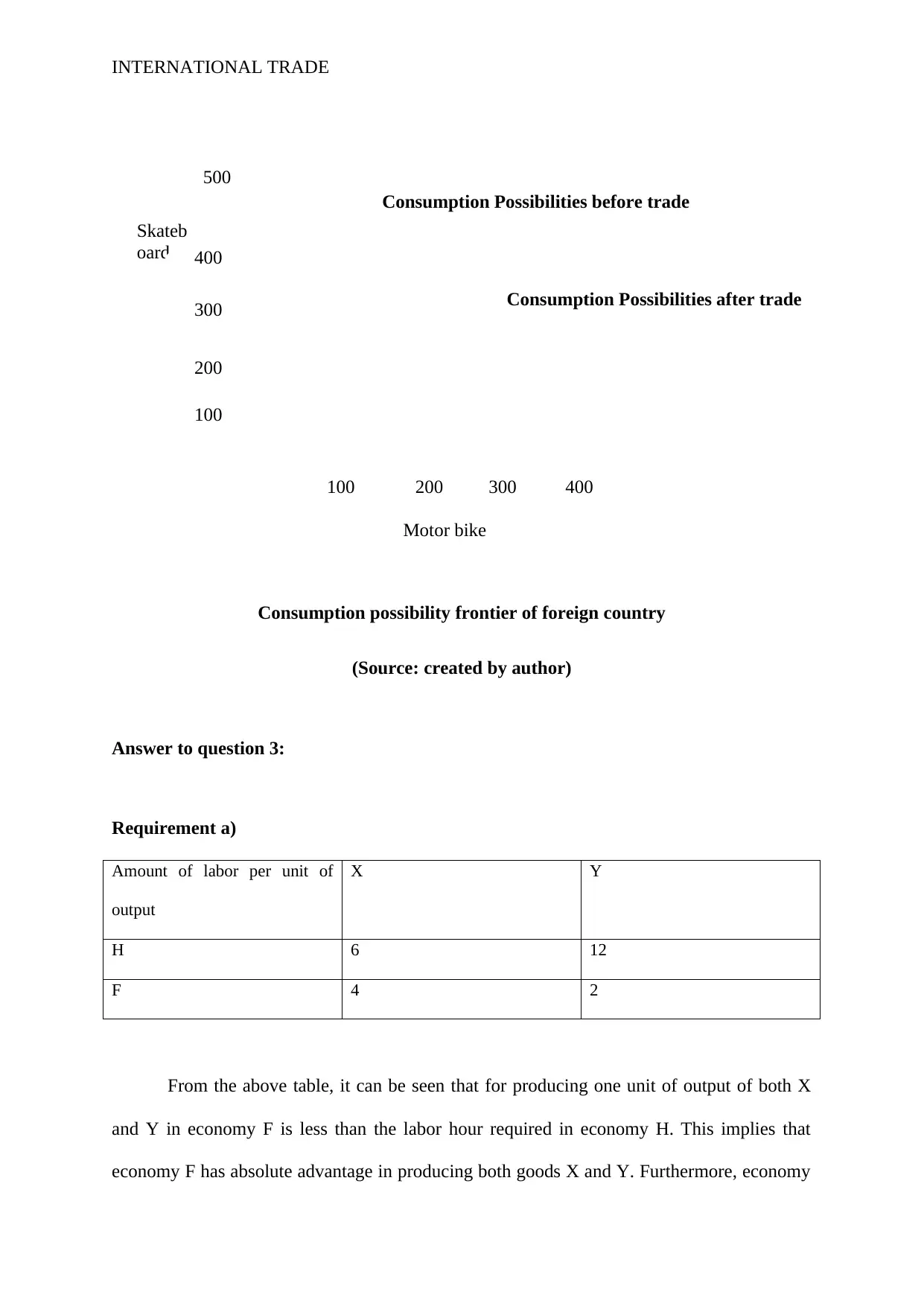
Motor bike
Skateb
oard
100 200
100
200
300
400
300 400
500
Consumption Possibilities before trade
Consumption Possibilities after trade
INTERNATIONAL TRADE
Consumption possibility frontier of foreign country
(Source: created by author)
Answer to question 3:
Requirement a)
Amount of labor per unit of
output
X Y
H 6 12
F 4 2
From the above table, it can be seen that for producing one unit of output of both X
and Y in economy F is less than the labor hour required in economy H. This implies that
economy F has absolute advantage in producing both goods X and Y. Furthermore, economy
Skateb
oard
100 200
100
200
300
400
300 400
500
Consumption Possibilities before trade
Consumption Possibilities after trade
INTERNATIONAL TRADE
Consumption possibility frontier of foreign country
(Source: created by author)
Answer to question 3:
Requirement a)
Amount of labor per unit of
output
X Y
H 6 12
F 4 2
From the above table, it can be seen that for producing one unit of output of both X
and Y in economy F is less than the labor hour required in economy H. This implies that
economy F has absolute advantage in producing both goods X and Y. Furthermore, economy
⊘ This is a preview!⊘
Do you want full access?
Subscribe today to unlock all pages.

Trusted by 1+ million students worldwide
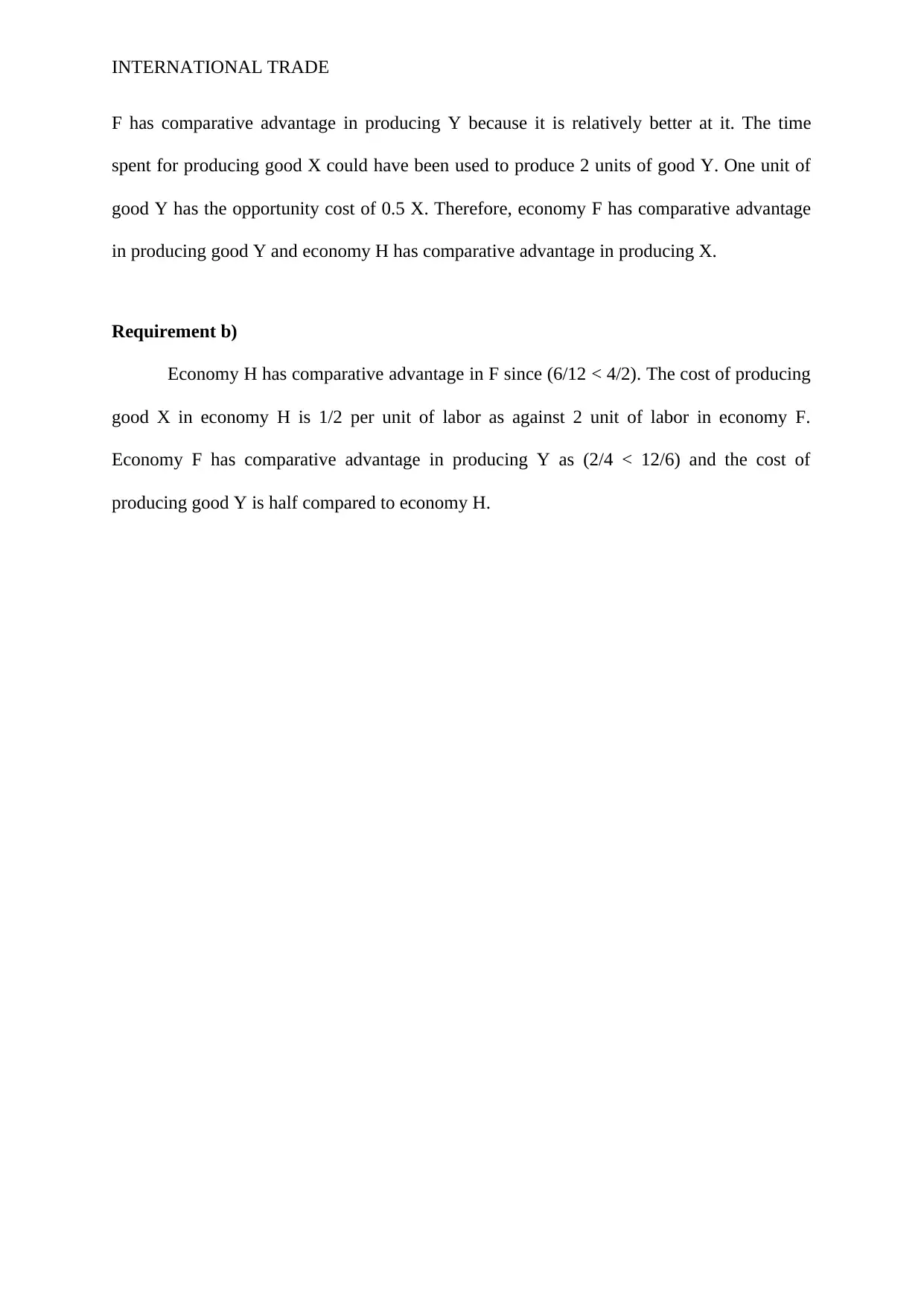
INTERNATIONAL TRADE
F has comparative advantage in producing Y because it is relatively better at it. The time
spent for producing good X could have been used to produce 2 units of good Y. One unit of
good Y has the opportunity cost of 0.5 X. Therefore, economy F has comparative advantage
in producing good Y and economy H has comparative advantage in producing X.
Requirement b)
Economy H has comparative advantage in F since (6/12 < 4/2). The cost of producing
good X in economy H is 1/2 per unit of labor as against 2 unit of labor in economy F.
Economy F has comparative advantage in producing Y as (2/4 < 12/6) and the cost of
producing good Y is half compared to economy H.
F has comparative advantage in producing Y because it is relatively better at it. The time
spent for producing good X could have been used to produce 2 units of good Y. One unit of
good Y has the opportunity cost of 0.5 X. Therefore, economy F has comparative advantage
in producing good Y and economy H has comparative advantage in producing X.
Requirement b)
Economy H has comparative advantage in F since (6/12 < 4/2). The cost of producing
good X in economy H is 1/2 per unit of labor as against 2 unit of labor in economy F.
Economy F has comparative advantage in producing Y as (2/4 < 12/6) and the cost of
producing good Y is half compared to economy H.
Paraphrase This Document
Need a fresh take? Get an instant paraphrase of this document with our AI Paraphraser
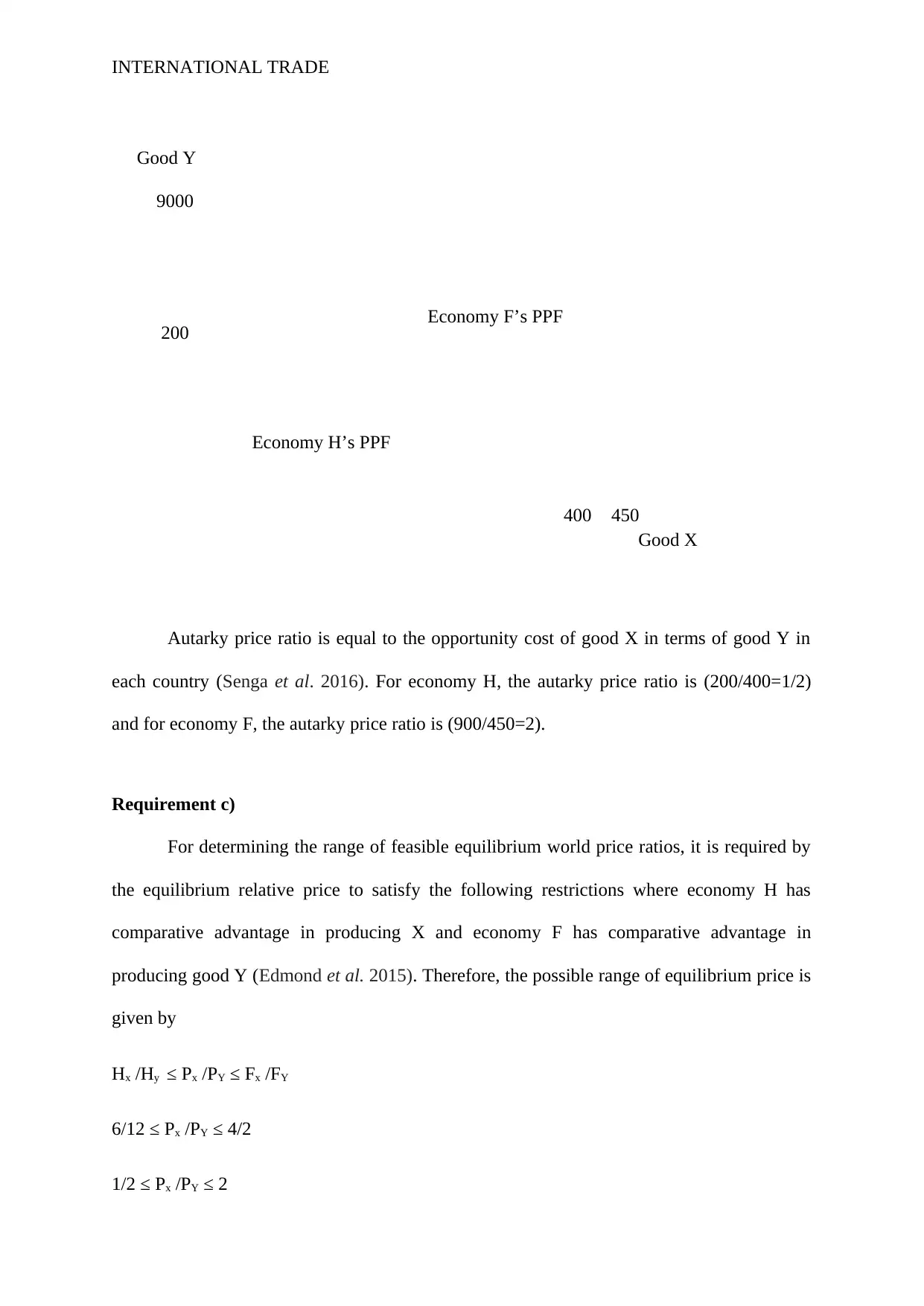
Good X
Good Y
400
200
450
9000
Economy F’s PPF
Economy H’s PPF
INTERNATIONAL TRADE
Autarky price ratio is equal to the opportunity cost of good X in terms of good Y in
each country (Senga et al. 2016). For economy H, the autarky price ratio is (200/400=1/2)
and for economy F, the autarky price ratio is (900/450=2).
Requirement c)
For determining the range of feasible equilibrium world price ratios, it is required by
the equilibrium relative price to satisfy the following restrictions where economy H has
comparative advantage in producing X and economy F has comparative advantage in
producing good Y (Edmond et al. 2015). Therefore, the possible range of equilibrium price is
given by
Hx /Hy ≤ Px /PY ≤ Fx /FY
6/12 ≤ Px /PY ≤ 4/2
1/2 ≤ Px /PY ≤ 2
Good Y
400
200
450
9000
Economy F’s PPF
Economy H’s PPF
INTERNATIONAL TRADE
Autarky price ratio is equal to the opportunity cost of good X in terms of good Y in
each country (Senga et al. 2016). For economy H, the autarky price ratio is (200/400=1/2)
and for economy F, the autarky price ratio is (900/450=2).
Requirement c)
For determining the range of feasible equilibrium world price ratios, it is required by
the equilibrium relative price to satisfy the following restrictions where economy H has
comparative advantage in producing X and economy F has comparative advantage in
producing good Y (Edmond et al. 2015). Therefore, the possible range of equilibrium price is
given by
Hx /Hy ≤ Px /PY ≤ Fx /FY
6/12 ≤ Px /PY ≤ 4/2
1/2 ≤ Px /PY ≤ 2
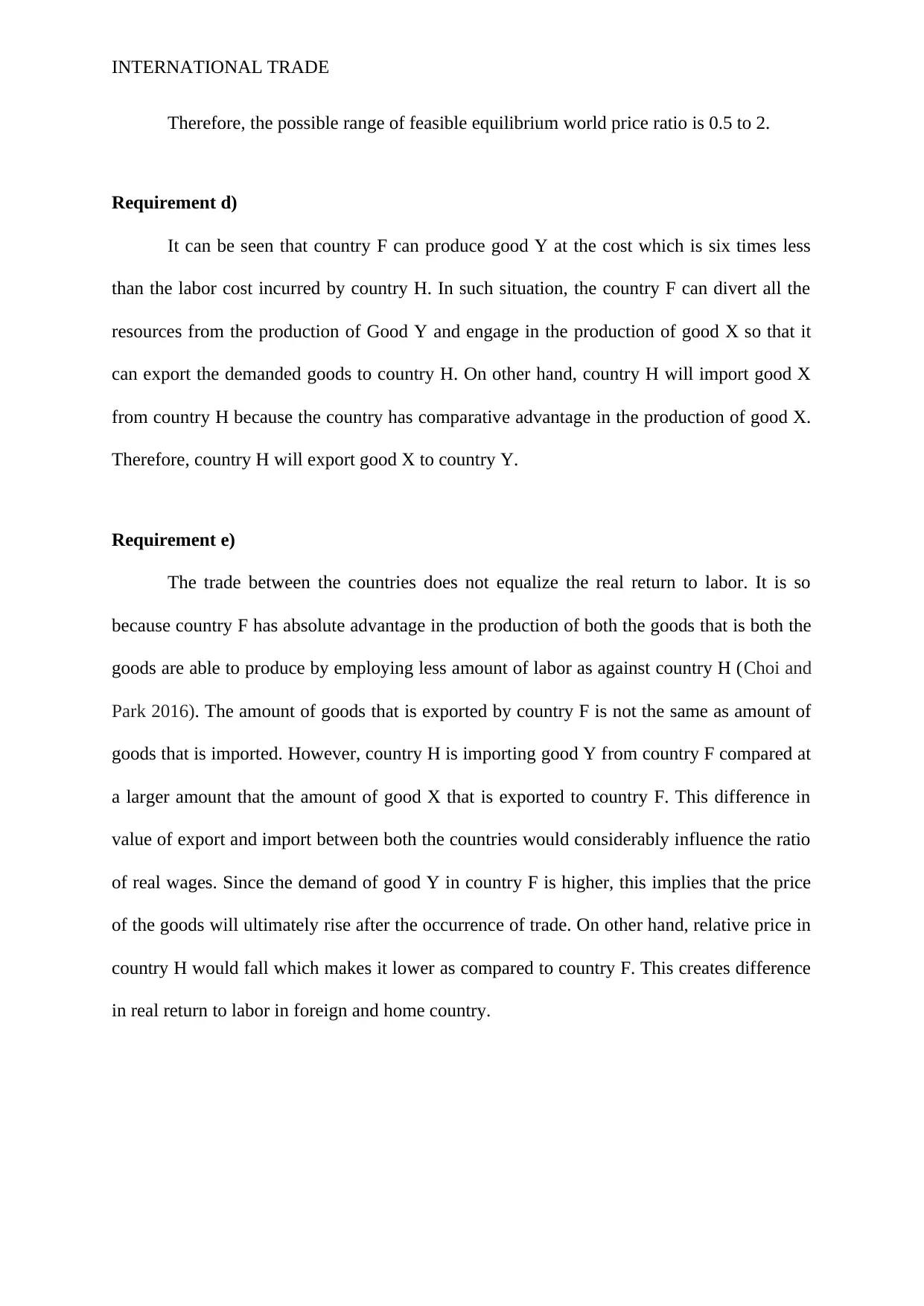
INTERNATIONAL TRADE
Therefore, the possible range of feasible equilibrium world price ratio is 0.5 to 2.
Requirement d)
It can be seen that country F can produce good Y at the cost which is six times less
than the labor cost incurred by country H. In such situation, the country F can divert all the
resources from the production of Good Y and engage in the production of good X so that it
can export the demanded goods to country H. On other hand, country H will import good X
from country H because the country has comparative advantage in the production of good X.
Therefore, country H will export good X to country Y.
Requirement e)
The trade between the countries does not equalize the real return to labor. It is so
because country F has absolute advantage in the production of both the goods that is both the
goods are able to produce by employing less amount of labor as against country H (Choi and
Park 2016). The amount of goods that is exported by country F is not the same as amount of
goods that is imported. However, country H is importing good Y from country F compared at
a larger amount that the amount of good X that is exported to country F. This difference in
value of export and import between both the countries would considerably influence the ratio
of real wages. Since the demand of good Y in country F is higher, this implies that the price
of the goods will ultimately rise after the occurrence of trade. On other hand, relative price in
country H would fall which makes it lower as compared to country F. This creates difference
in real return to labor in foreign and home country.
Therefore, the possible range of feasible equilibrium world price ratio is 0.5 to 2.
Requirement d)
It can be seen that country F can produce good Y at the cost which is six times less
than the labor cost incurred by country H. In such situation, the country F can divert all the
resources from the production of Good Y and engage in the production of good X so that it
can export the demanded goods to country H. On other hand, country H will import good X
from country H because the country has comparative advantage in the production of good X.
Therefore, country H will export good X to country Y.
Requirement e)
The trade between the countries does not equalize the real return to labor. It is so
because country F has absolute advantage in the production of both the goods that is both the
goods are able to produce by employing less amount of labor as against country H (Choi and
Park 2016). The amount of goods that is exported by country F is not the same as amount of
goods that is imported. However, country H is importing good Y from country F compared at
a larger amount that the amount of good X that is exported to country F. This difference in
value of export and import between both the countries would considerably influence the ratio
of real wages. Since the demand of good Y in country F is higher, this implies that the price
of the goods will ultimately rise after the occurrence of trade. On other hand, relative price in
country H would fall which makes it lower as compared to country F. This creates difference
in real return to labor in foreign and home country.
⊘ This is a preview!⊘
Do you want full access?
Subscribe today to unlock all pages.

Trusted by 1+ million students worldwide
1 out of 14
Related Documents
Your All-in-One AI-Powered Toolkit for Academic Success.
+13062052269
info@desklib.com
Available 24*7 on WhatsApp / Email
![[object Object]](/_next/static/media/star-bottom.7253800d.svg)
Unlock your academic potential
Copyright © 2020–2026 A2Z Services. All Rights Reserved. Developed and managed by ZUCOL.




